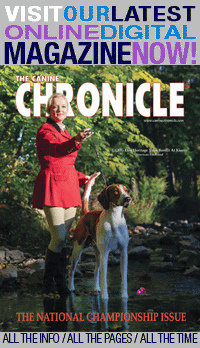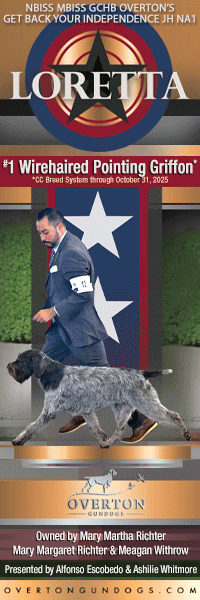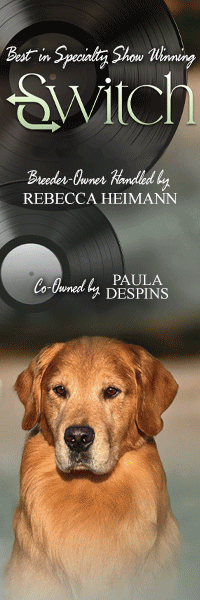More than Just a Pretty Face
Click here to read the complete article
By Annika Dechert
 Shanaea VanderPol is a 17 year-old upcoming senior at Kelly Walsh High School in Casper, Wyoming. She competes in AKC conformation and junior showmanship with her golden retriever, River Golden Cream Soda. Jennifer Necker is a 16 year-old upcoming junior at Los Alamos High School in Los Alamos, New Mexico. She competes with her English setter, GCh. Iobelra Flow’N Owen RN NA NAJ in conformation, showmanship, and agility. Annika Dechert is a 17 year-old upcoming freshman at Occidental College in Los Angeles, California. She competes in conformation and showmanship with her smooth fox terrier, GCh. High Mtn’s Lightning Thief. These three girls have taken advantage of training techniques they learned as AKC competitors to tap into their dogs’ extraordinary capabilities in order to provide potentially life-saving services. Each of these show dogs has become more than just a “pretty face”: these show dogs are also service dogs. Here are their stories.
Shanaea VanderPol is a 17 year-old upcoming senior at Kelly Walsh High School in Casper, Wyoming. She competes in AKC conformation and junior showmanship with her golden retriever, River Golden Cream Soda. Jennifer Necker is a 16 year-old upcoming junior at Los Alamos High School in Los Alamos, New Mexico. She competes with her English setter, GCh. Iobelra Flow’N Owen RN NA NAJ in conformation, showmanship, and agility. Annika Dechert is a 17 year-old upcoming freshman at Occidental College in Los Angeles, California. She competes in conformation and showmanship with her smooth fox terrier, GCh. High Mtn’s Lightning Thief. These three girls have taken advantage of training techniques they learned as AKC competitors to tap into their dogs’ extraordinary capabilities in order to provide potentially life-saving services. Each of these show dogs has become more than just a “pretty face”: these show dogs are also service dogs. Here are their stories.
Shanaea VanderPol
At about six years old, I was diagnosed with Type 1 diabetes. Since that time, I have had a history of diabetic seizures from extremely low blood sugar. This is highly dangerous and can lead to death. Therefore, having an alert dog lowers the chances of medical complications due to diabetic seizures. Since I have been around dogs my whole life, I began to do research about the training of diabetic services dogs. Initially, I looked into a training school, but the schools were extremely expensive and far from home. I then decided to work with my golden retriever, Buddy, and do the training on my own. Scientists aren’t exactly sure how dogs can tell when a human’s blood sugar is low, but they believe it has something to do with the smell of our breath. I began our training with that concept. First, I would breathe into a pill bottle (to concentrate the smell) every time my blood sugar went low, let him smell it, and then give him a treat. Later, he would have to smell the pill bottle and then touch my arm to get a cookie. After extended training, he began alerting on his own when my blood sugar got too low, normally around 60 mg/dL. He now nudges my arm or thigh with his nose to alert me. In fact, he alerted me at the Golden Retriever Nationals four years ago. We were sitting outside the ring getting ready to go in for Junior Showmanship. I felt strange, but it was extremely hot so I thought it was from the heat. Buddy would not leave me alone and he was really starting to annoy me. All of a sudden, his message clicked; I went to check my blood sugar and it was 62. That was the first time he had alerted me at a dog show. My blood sugar problems mostly happen at night, especially when I am away from home. Therefore, he is especially important for me when I am on the road. Not only is Buddy an AKC conformation and Junior Showmanship dog, he is also a licensed therapy dog. We visit the Wyoming Behavioral Institution to visit sick and injured patients and help them feel better about their current situation. So, Buddy is a show dog, a therapy dog, and a service dog.
Jennifer Necker
When I was young, I found out that I am allergic to peanuts. If I eat peanuts, my throat gets itchy, my tongue swells, and I can go into anaphylactic shock, which can result in death. My mom is also allergic to nuts, but her reaction isn’t as severe. My family read an article about service dogs trained to detect foods to which their owners are allergic. After reading the article, we decided to attend a scent-training facility in Santa Fe called Lucky Dog to see if our dog could be trained to help us. My English setter, Owen, participates in conformation, junior showmanship, and agility with me. So, we brought him to the facility to see if he could also search for foods with peanuts. It took about six months for him to reliably search for peanuts and alert me when he found them. We continue to practice the alert every month or so to refresh his skills. Owen can now search for peanuts for both my mom and me, but because my allergic reactions are so severe, I still carry an Epi-Pen just in case. My mom and I also visit schools to talk about what Owen can do. One time, as we were showing a class Owen’s skills, not only did he find the peanuts that my mom hid, he also found a kid’s peanut butter sandwich on a bag on the book shelf! The kids thought that was pretty funny. In addition to participating in AKC events and being a service dog, Owen is also a working therapy dog. He visits schools to tell children what service dogs do, visits assisted living facilities, and does home visits for a local hospice. Because Owen is getting older, we are working with my younger English setter, Pippa, so that she can take over his duties. She is still learning, and getting better every day. Although English setters are not a typical service dog breed, both Owen and Pippa have proven themselves to be invaluable service animals.
Annika Dechert
You could say that my family has pancreas problems…My great-grandmother had hypoglycemia, my mother has Type 1 diabetes, and I am also hypoglycemic. I have learned to control it through what and how I eat, but I still have problems in the morning, during sports, and during events when it is difficult to eat regularly. Because my mother and I both have issues with our blood sugar going low, we were excited when we saw a documentary on TV about a seeing-eye dog who was also being trained to detect low blood sugar for its owner. After training dogs in agility, obedience, rally, and conformation, it appeared that the training for low blood sugar detection really wouldn’t be that difficult. So, we decided to give it a try and started working with my smooth fox terrier, Percy, because of his intelligence, willingness to please, and small size. Some people believe that terriers aren’t very trainable; however, terriers are highly intelligent, but different training methods are needed than for more traditional serving breeds. We had to make Percy believe that he was playing a game, that it was fun to tell us when our blood sugar was low. Since my mom can force her blood sugar low through medication, she was the guinea pig. She would force her blood sugar low and then call Percy to her, breath on him, tell him “good low,” give him a cookie, and play with him. With this training method, Percy began alerting on his own in about two weeks. Percy now knows to alert either of us if our blood sugar goes low. In fact, he once alerted mom, but when she went to check her blood sugar, it was only about 90. We thought that Percy had made a mistake, but within 10 minutes mom’s blood sugar was down to 60. Therefore, Percy somehow knew that her blood sugar was crashing, something a glucometer is not able to tell her. Percy has now accompanied us on many adventures to watch over us. Of course, he comes with us when we travel, and he has been to the Met in New York City, the Field Museum in Chicago (his all-time favorite exhibit is Sue the T-Rex), many sporting events, and even kayaking. Percy has proven that he is more than just a Grand Champion show dog who has competed at both Eukanuba and Westminster. He provides a vital, potentially life saving service to both my mom and me.
In the show world, we train our dogs to gait correctly, stand for exam, and self-stack. In agility, we train our dogs to jump through tires, run through tunnels, and weave through poles. If we can train our dogs to do those things, then why couldn’t we also train our dogs to perform a service to help society? That’s exactly what we did, even though we’re young. Our show dogs are capable of so much more than just being a pretty face.
Short URL: http://caninechronicle.com/?p=82835
Comments are closed











